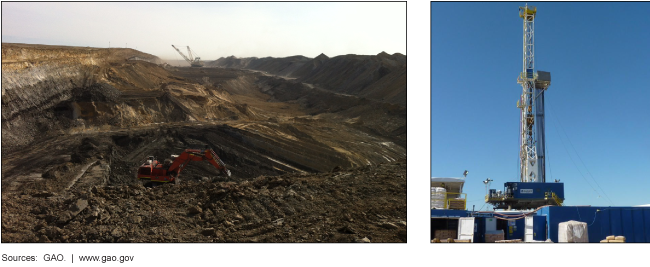Oil, Gas, and Coal Royalties: Raising Federal Rates Could Decrease Production on Federal Lands but Increase Federal Revenue
Fast Facts
The federal government collected $2.5 billion in revenue from onshore oil, gas, and coal production on federal lands in fiscal year 2016, including about $2 billion from royalties. While the federal royalty rates for coal production are generally the same or higher than state rates, federal rates for oil and gas production are generally lower than state rates.
We reviewed studies and interviewed stakeholders about federal royalty rates and found that increasing these rates may slightly decrease production on federal lands. However, it could increase revenue by millions of dollars annually.
Surface coal mining (left) and oil and gas drilling (right).

Photos of a surface coal mine and an oil and gas drilling rig.
Highlights
What GAO Found
Raising federal royalty rates—a percentage of the value of production paid to the federal government—for onshore oil, gas, and coal resources could decrease oil, gas, and coal production on federal lands but increase overall federal revenue, according to studies GAO reviewed and stakeholders interviewed. However, the extent of these effects is uncertain and depends, according to stakeholders, on several other factors, such as market conditions and prices.
Production. One study GAO reviewed found that oil and gas production could decrease by less than 2 percent per year if royalty rates increased from their current 12.5 percent to 22.5 percent, based on fiscal year 2016 production data. Another study stated the effect on production could be “negligible” over 10 years if royalty rates increased to 18.75 percent, particularly if the increased federal royalty rate remained equal to or below the royalty rates for production on state or private lands. Regarding coal, one study suggested that raising the federal royalty rate for coal to 17 percent would decrease production on federal lands by up to 3 percent after changes were fully implemented after 2025, while a second study said that increasing the effective rate—the rate actually paid by companies after processing and transportation allowances have been factored in, along with any royalty rate reductions—might decrease production on federal lands by less than 1 percent per year. Some stakeholders said that several other factors could influence the extent to which oil, gas, and coal production might decline. For example, some stakeholders said current market conditions, the cost advantages of different resources, and the regulatory burden associated with production on federal lands could influence the extent to which production might decline.
Revenue. The oil and gas studies that GAO reviewed estimated that raising the federal royalty rate could increase net federal revenue between $5 million and $38 million per year. One of the studies stated that net federal revenue would increase under three scenarios that modeled raising the royalty rate from the current 12.5 percent to 16.67 percent, 18.75 percent, or 22.5 percent, while the other study noted that the effect on federal revenue would initially be small but would increase over time. Both coal studies suggested that a higher royalty rate could lead to an increase in federal revenues. One of the studies suggested that raising the royalty rate to 17 percent or 29 percent might increase federal revenue by up to $365 million per year after 2025. The other study suggested that increasing the effective rate could bring in an additional $141 million per year in royalty revenue. Stakeholders GAO interviewed cited other factors that could influence the extent to which raising federal royalty rates could increase revenues—in particular, how bonus bids, another revenue source, could be affected. Some of the stakeholders stated that companies would be more likely to offer lower bids to obtain a lease for the rights to extract resources if they had to pay higher royalties.
Why GAO Did This Study
In fiscal year 2016, the federal government collected about $2.5 billion in revenue associated with onshore oil, gas, and coal production on federal lands, including about $2 billion from royalties. Federal royalty rates sometimes differ from the rates states charge for production on state lands. For example, state oil and gas rates tend to be higher than federal royalty rates and state coal rates are generally the same as federal rates in the six states representing more than 90 percent of federal oil, gas, and coal production in fiscal year 2015.
The explanatory statement accompanying the Consolidated Appropriations Act for fiscal year 2016 includes a provision for GAO to review issues related to royalty rates. This report describes what is known about how raising federal royalty rates would affect (1) oil, gas, and coal production on federal lands and (2) the federal revenue associated with such production. GAO reviewed an extensive list of studies and selected for more in-depth review four that modeled the effects of raising federal royalty rates—one study conducted by the Congressional Budget Office, one by the Council of Economic Advisers in the Executive Office of the President, one prepared for the Bureau of Land Management, and one by researchers. GAO also interviewed officials from federal and state agencies, industry groups, non-governmental organizations, academia, and other knowledgeable stakeholders.
GAO is not making recommendations in this report. Interior reviewed a draft of this report and provided technical comments that GAO incorporated as appropriate.
For more information, contact Frank Rusco at (202) 512-3841 or ruscof@gao.gov.
